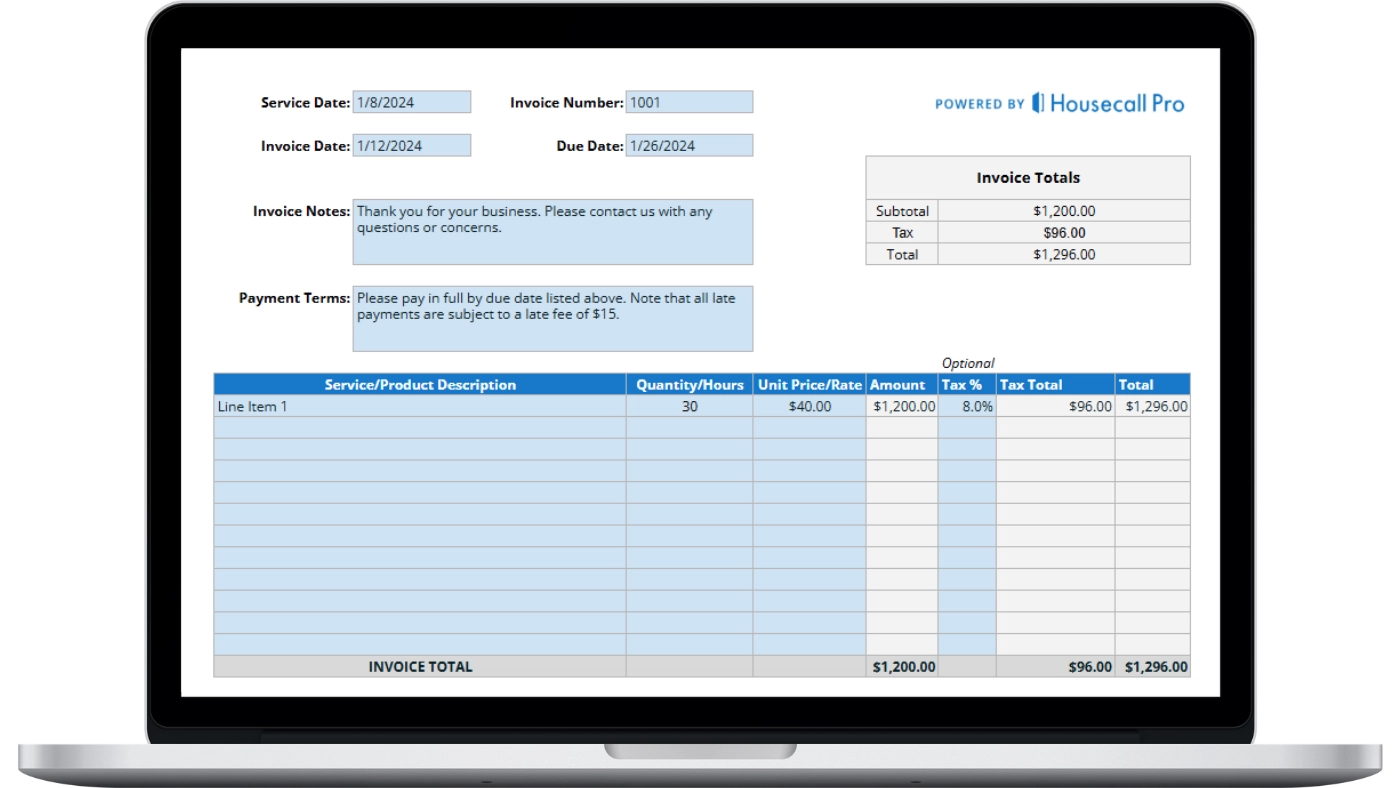Spending too much time on admin work?
Automate your daily tasks and save time with our home service software.
Want to win more jobs with less effort?
Grow your business and send quick quotes with our home service software.

Looking to boost your HVAC business’s online presence and attract more customers? You’re not alone. Every month, countless individuals turn to search engines to search for heating and cooling services.
A whopping 60% of marketers consider SEO, and blog content as their top source for high-quality leads. What’s more, SEO leads boast a higher closing rate compared to traditional marketing methods. This makes investing in SEO and content marketing a lucrative opportunity for HVAC businesses. So, if you’re eager to enhance your search engine optimization strategy and capitalize on the potential of SEO leads, we’ve rounded up 12 tips to help achieve that.
Reach your business goals with these 12 SEO tips for HVAC contractors
Whether you’re a seasoned contractor or a newcomer to the field, these 12 SEO tips will revolutionize the way you approach digital marketing, empowering you to achieve your business goals with confidence and precision.
1. Local keyword research for HVAC contractors
Audience research, along with local keyword research, stands out as a cornerstone strategy for success. Why? Because it’s not just about reaching any audience; it’s about targeting the right audience – those in your service area actively seeking HVAC services. To do this, you’ll need to your target audience and the intent behind their search. Are they seeking DIY information on how to repair a heater? Or are they seeking a reputable HVAC contractor to do it for them?
This is where keyword research comes into play. Keyword research involves analyzing search volume, intent, and relevance to your services. Phrases with local modifiers, such as “furnace repair [City Name] reviews,” hold immense potential to drive targeted traffic.
Understanding different keyword types
Understanding the different keyword types is crucial for optimizing your website content accordingly.
Informational keywords are used for seeking information, while local keywords target specific geographic areas, and commercial keywords focus on products or services. For example, “HVAC maintenance tips” is an informational keyword fit for a blog post.
“HVAC service Los Angeles” is a local keyword, indicating a clear intention to find a local provider imminently. “Best HVAC contractor” is a commercial keyword highlighting people seeking a specific service. These high-intent searches are golden opportunities for HVAC businesses to connect with potential clients who are ready to convert.
Adding keywords to your site’s content
Using high-intent local keywords strategically throughout your website content is pivotal to optimizing your site for local searches.
Make a list of your primary keywords along with a list of secondary keywords so you can connect them to each page on your website. Each page should target one target keyword and two to five secondary keywords. Once you have a keyword list, focus on adding them to these areas of your site:
- Homepage: Add city or region-specific terms in headings and opening paragraphs to signal to search engines your service area. For example, if you serve New York City, mention “New York City HVAC Services” prominently.
- Service Pages: Ensure service-specific and geo-targeted keywords are integrated into descriptive text on service pages. For instance, if you offer air conditioning repair in Los Angeles, mention “Los Angeles air conditioning repair” in the service description.
- Meta Tags: Include local search terms in meta titles and descriptions for each page to optimize them for search engine results. For example, your meta title for an HVAC installation page could be “Expert HVAC Installation Services in Dallas, TX.”
- Image Alt Text: Utilize geo-referenced keywords in alt attributes of relevant images. If you have an image of an HVAC technician working in Chicago, the alt text could be “Chicago HVAC technician at work.”
- URL: Incorporate keywords into your URL structures. For example, if you have a page about furnace maintenance in Boston, the URL could be “yourwebsite.com/boston-furnace-maintenance.”
Tact and discretion are key; keywords should enhance, not hinder, the readability of your text. Avoid keyword stuffing and writing for search engines. Instead, write for humans first and then optimize with keywords naturally in your site’s content, but don’t force them.
Keyword research tools
HVAC companies can invest in various free and paid tools to perform keyword research to find your most profitable keywords. Here are a few popular SEO tools:
Moz: Offers comprehensive SEO tools, including keyword research capabilities
AHREFS: Known for its robust features in keyword research and competitive analysis
SEMrush: Provides a suite of SEO tools, including keyword research functionalities
These tools can assist HVAC businesses in identifying relevant keywords and understanding search volume, competition, and search intent. ultimately optimizing your website for more related keywords that resonate with your local audience.
2. Optimize your HVAC websites’ on-page SEO
Your website is your digital storefront, and each service you offer should have a dedicated page that details what your company provides. Search engines rank individual web pages and having unique, well-written content will put you in a great position for optimal rankings. Focus on optimizing the critical on-page SEO factors of your website. This is the visible facto visitors can see and interact with.
This is your chance to show your expertise by adding engaging pictures, creating detailed service descriptions, and showing your customers the value of doing business with you.
Let’s take a look at how you can create and fine-tune your website’s on-page SEO:
Create detailed local service area pages
Your services deserve dedicated pages where you can showcase your expertise. Instead of skimming the surface, dive into each service with detailed descriptions, highlighting its benefits, features, and how you address customers’ needs. For instance, if you offer AC repair, elaborate on the common issues you address, the tools and techniques you use, and the benefits of choosing your service over competitors.
Improve your website’s relevancy by strategically using relevant local keywords throughout your content. From the URL and title tags to meta descriptions and header tags, ensure your target keywords are seamlessly integrated. These on-page factors signal to search engines the relevance of your content, improving your chances of ranking higher in search results. For instance, if you specialize in emergency AC repair in target markets like Miami, ensure these keywords are featured in your page elements.
Work on improving your HVAC Website’s user experience
Engaging visuals, such as before-and-after images of successful repairs or installations, can captivate visitors and showcase your workmanship. Showcasing testimonials or reviews from satisfied customers adds social proof and instills trust. According to industry data, 90% of consumers read online reviews before visiting a business, highlighting the importance of leveraging positive feedback to your advantage.
Make it effortless for visitors to navigate your website by including an intuitive navigation menu. Guide them to related pages or services, helping their journey through your site with internal linking. Additionally, ensure your website loads swiftly by optimizing image sizes by compressing your images to smaller sizes. Studies show that 40% of visitors abandon a website if it takes more than three seconds to load, underscoring the importance of a fast website.
Encourage visitors to take the next step by incorporating clear and compelling CTAs throughout your service pages. Whether it’s prompting them to schedule a repair, request a free estimate, or contact you for emergency AC repair services, ensure these CTAs are prominently displayed above the fold. By guiding visitors towards action, you increase the likelihood of conversion and ultimately grow your business.
3. Focus on writing helpful HVAC content
In addition to service pages, blog content provides an opportunity to address topics requiring more in-depth coverage than a service page allows. A blog provides HVAC contractors with a platform to educate and inform their customers about various HVAC-related topics. By addressing common questions and concerns through valuable content creation, HVAC contractors showcase their expertise and knowledge in the industry.
Given you write informative and helpful content, this establishes you as an authority in your market. Your brand is more likely to stay top of mind if you truly write content to help people.
Use your HVAC blog to establish authority within your industry, answer common questions your audience may have, and showcase your expertise. HVAC companies should create long-form, informative content that provides value to their readers. This can include DIY and how-to guides, industry news, and expert insights.
By consistently providing valuable content, such as maintenance tips, energy-saving techniques, or industry trends, HVAC contractors can build trust with existing customers. This content also attracts potential clients who are seeking reliable information and solutions to their HVAC-related problems.
How to get fresh content ideas for your blog
To get content ideas be sure to do more keyword research and monitor your social media channels. If you’re just starting and haven’t posted on social media yet, go look into what your competitors are writing about. Check their social media channels, read their content, and think of different angles or ways you could expand and provide more value on the topic.
As you conduct your research, think about common questions your customers may ask. These can be excellent blog topics. For example, “Why is my AC not cooling properly?” or “How often should I change my furnace filter?” Start typing relevant keywords in the Google search bar to see the auto-suggestions. These are common queries people have related to HVAC. You can use them as blog topics.
Posting alone is not enough. You need to post consistently to signal to search engines that your site is truly trying to help people. Remember to make a content calendar. Consistent posting is the key to growing your audience.
Local SEO strategies for HVAC contractors
Local SEO is all about location and can help HVAC contractors improve their credibility by appearing in local search results and Google Maps listings. This inbound marketing approach saves money compared to outbound strategies such as cold-calling. This is a cost-effective way to promote HVAC services because it targets users who are actively looking for your products and services.
Here’s how you can take advantage of Local SEO to help you rise in the rankings:
4. Claim your free Google Business Profile
Having a Google Business Profile (formerly Google My Business) adds a layer of trust. People often trust Google-backed information, so your profile lends credibility to your HVAC business.
Claiming your profile allows you to provide accurate contact information. Customers can quickly find your phone number, address, and website, making it easier for them to get in touch with you. Focus on these key areas of your Google Business Profile:
Verification: Verify your business to enhance credibility and visibility on Google.
Choose the Right Categories: Select relevant business categories to improve the accuracy of search results. Choose the most suitable business category to attract the right audiences. For example, choose “HVAC Contractor” “Heating Contractor” and “Air conditioning contractor.”
Complete Profile Information: Ensure your business name, address, phone number, and website URL are up-to-date. If you’re open 24 hours, make sure you have this reflected as well. List all of your service areas, turn on messaging, add your booking link, and fill in your services and products to make your profile as complete as can be.
Business Description: Write a concise yet engaging description that highlights your HVAC services, expertise, unique selling points, and how long you have been in business.
Regular Updates: Keep your business hours, contact information and other details updated to maintain relevance. Upload professional photos showcasing your HVAC work, team members, and office space to build credibility and attract customers.
Reviews: Encourage reviews and respond to both positive and negative ones. Engaging with your audience builds trust and rapport. The more positive reviews you accumulate, the more trustworthy and authoritative your HVAC business appears in the eyes of Google.
5. Collaborate with local businesses
Collaborating with local businesses opens doors to countless opportunities. Together, you can cross-promote, share backlinks, and amplify each other’s online presence. Imagine a handyman recommending your HVAC services when someone’s heating system goes haywire. You scratch their back; they scratch yours, and Google takes notice. It’s a win-win strategy.
Off-Page SEO Tactics for HVAC Companies
You might be wondering, what are off-page SEO tactics? This simply means changing the SEO elements not immediately visible to visitors. Think of this as the behind-the-scenes work that happens off your webpage’s front end.
6. Improve your website’s authority through link building
Earning high-quality backlinks is like forging alliances with powerful kingdoms. It’s about who you know and who knows you. When reputable websites link back to your HVAC site, it’s like them vouching for your authority.
HVAC companies should invest in link building because it is a critical component of off-site SEO factors that can significantly improve their website’s visibility and search engine rankings. By creating quality content assets and earning links from reputable sources, HVAC companies can establish themselves as industry authorities and attract more targeted traffic to their website.
For example, a local HVAC company could create an informative blog post about the importance of regular HVAC maintenance and share it on social media platforms. This content asset could then be picked up by a local news outlet or industry blog, resulting in a high-quality backlink that improves the company’s search engine rankings and drives more relevant traffic to its website.
7. Post helpful content on your social media profiles
HVAC companies should invest in posting helpful HVAC content on their social media accounts because it is a crucial part of their digital marketing efforts and digital marketing strategy. By sharing informative and engaging content, you can attract a wider audience, establish yourself as an industry expert, and increase the chances of your content being found by the right people.
For example, an HVAC company could create a series of short videos explaining common HVAC problems and how to fix them. By sharing these videos on social media platforms like Facebook, Twitter, and Instagram, the company can reach a broader audience, answer common questions, and demonstrate its expertise in the field. This social media marketing strategy can also improve their search engine rankings, as search engines like Google consider social media signals when determining website relevance for a given search query. You also can have your content go viral, further expanding your reach and establishing your market authority.
Get In Touch: 858-842-5746
Let us earn your trust
See plan options and feature breakdown on our pricing page.
8. Build citations through HVAC directory listings
Directory listings are your business’s digital signposts. Think of them as the roadmap that helps customers find you. When you ensure your HVAC business is listed accurately in online directories, you’re making it easy for potential customers to discover you. It’s like placing your business on the busiest street in town.
Ensure consistent NAP information for trust and accuracy
In local SEO, a consistent Name, Address, and Phone number (NAP) across all online touchpoints is non-negotiable. Deviations can confuse search engines and potential clients alike, undermining your credibility and discoverability.
Keep this trio identical on every platform. Any discrepancy can dilute your local SEO efficacy and misdirect prospective customers.
Five directories HVAC businesses can get listed on:
- Google My Business
- Yelp
- Yellow Pages
- Angie’s List
- HomeAdvisor
Accurate directory listings boost your local SEO efforts, ensuring you’re in the right place at the right time when customers are searching for HVAC services.
9. Video content: the rising Sstar in SEO
Video content is the rising star in the SEO galaxy. Think of it as your lightsaber, a powerful weapon that can cut through digital noise. Creating engaging HVAC videos is like telling your story in the most captivating way.
People love watching videos, and search engines love websites that offer various content types. Aim to start a YouTube channel and optimize your videos for search engines. YouTube, is in fact the second-largest search engine behind Google. By producing video content, you not only connect with your audience on a deeper level but also send a signal to search engines that your HVAC business is on the cutting edge of SEO. It’s like mastering the Jedi arts of SEO – powerful and respected throughout the galaxy.
Technical SEO for HVAC Contractors
This pillar focuses on the technical aspects of a website, such as site speed, mobile-friendliness, and user experience. Technical SEO ensures that search engines can easily crawl and index a website, which can improve its search engine rankings.
10. Improve your HVAC website speed and performance
Your website’s speed and performance are like the engines of your SEO spaceship. If they’re not in top shape, you’ll never reach your destination. Page load times can either catapult you to the top or drag you down in search rankings.
Slow-loading websites frustrate users and send them elsewhere. It’s like having a restaurant with a slow kitchen; customers won’t wait. Optimizing your HVAC website’s speed is crucial. It’s the turbo-boost that propels you ahead in the SEO race.
Improving mobile page load speed
Pages that load rapidly cater to the immediacy mobile users expect, providing a competitive advantage in local HVAC markets.
Swift mobile page load times are crucial in retaining potential HVAC leads navigating on-the-go.
- Compress images to reduce file size without compromising quality.
- Minimize the use of heavy JavaScript and CSS.
- Leverage browser caching for returning visitors.
- Employ content delivery networks (CDNs) to distribute load.
- Streamline redirects to diminish request delays.
- Opt for accelerated mobile pages (AMP) when feasible.
By prioritizing mobile page speed, you elevate user experience and search engine rankings.
11. Optimize for mobile devices & searches
Mobile optimization is not up for negotiation—it’s essential. Swift navigation and readability matter immensely for on-the-go users searching for HVAC services.
Incorporating responsive design ensures your website adapts seamlessly across various devices, offering an optimal viewing experience that includes easy reading and navigation with minimal resizing, panning, and scrolling.
Usability is amplified by intuitive site structure. Clearly labeled menus, service categories, and pertinent information like business hours and emergency contact numbers should be front and center for users.
Consider implementing features like ‘click-to-call’ buttons for instant phone connectivity, and easily accessible quote forms to expedite the lead generation process right from a smartphone.
A mobile-friendly experience is not just for user satisfaction; it’s a significant factor in Google’s ranking algorithm, influencing your local SEO performance and lead generation capabilities.
12. Use these tools to track your HVAC company’s SEO campaigns
Given Google’s continuously evolving search algorithm, regularly analyzing HVAC SEO strategy’s effectiveness is vital to staying ahead of the curve. With ranking factors becoming obsolete every year, it’s essential to keep a close eye on your HVAC SEO campaigns.
Performance tracking serves as the guiding light for SEO adjustments. It’s crucial to vigilantly monitor your HVAC company’s key performance indicators (KPIs) for sustained growth. You might be wondering, what tools are at your disposal to bolster the SEO of your HVAC website?
Google Analytics 4: This tool provides valuable insights into your website’s performance, including traffic sources, user behavior, and conversion rates. By analyzing this data, you can identify areas for improvement and make informed decisions to boost your SEO efforts.
Google Search Console: GSC allows you to monitor your website’s presence in Google’s search results and identify any issues that may be affecting its performance. You can submit sitemaps, check for crawl errors, and view keyword rankings to optimize your HVAC website for better visibility.
SEMrush: As a comprehensive SEO tool, SEMrush provides features like keyword research, competitor analysis, and site auditing. By conducting thorough keyword research, you can identify relevant terms and phrases to optimize your website content, while competitor analysis helps you understand what strategies are working in your industry.
BrightLocal: This tool offers local SEO software that helps businesses manage and optimize their Google Business Profile. It provides tools for tracking local search rankings, monitoring citations, building citations, managing reviews, and generating white-label reports.
Tools like Google Analytics and Search Console are your trusty navigational instruments. They provide data, insights, and guidance. It’s like having the stars in the night sky to guide you. Regularly analyzing your SEO performance with these tools helps you make informed decisions and fine-tune your HVAC SEO marketing strategy.
The Takeaway
As we conclude our journey through these 12 SEO tips tailored specifically for HVAC contractors, it’s clear that the digital landscape holds immense potential for your business’s growth and success. By embracing the power of SEO and implementing these expert strategies, you’re not just optimizing your online presence – you’re laying the groundwork for unparalleled visibility and customer engagement in the competitive realm of heating and cooling services.
Remember, each tip is a building block toward your overarching goal of dominating local search and attracting high-quality leads. Whether you’re a seasoned contractor well-versed in digital marketing or a newcomer eager to make your mark, these insights offer a roadmap to navigate the complexities of SEO with confidence and precision.
So, as you embark on the next phase of your digital journey, armed with these invaluable SEO tips, seize the opportunity to elevate your HVAC business to new heights. Embrace innovation, stay agile, and watch as your efforts translate into tangible results, propelling your business toward unprecedented success in the ever-evolving digital landscape.
What are the benefits of Local SEO for HVAC businesses?
Improved User Experience: SEO enhances the overall user experience by ensuring websites are well-structured, quick to load, and optimized for the right audience, leading to a better user experience and reduced bounce rates
More Qualified Leads: SEO targets users actively searching for HVAC services, resulting in higher-quality traffic and more qualified leads, increasing the likelihood of conversions
Cost-Effective Marketing: SEO is a cost-effective marketing strategy that targets users already interested in HVAC services, saving money compared to outbound marketing methods like flyers.
Enhanced Credibility: A strong SEO strategy can boost brand awareness and credibility among search engine users, positioning HVAC businesses as trustworthy industry authorities
Increased Organic Visibility: SEO helps HVAC businesses reach clients organically through targeted searches like “HVAC contractors near me,” driving higher-quality traffic and visibility
What are some key metrics to track for HVAC SEO success?
As an HVAC contractor, it’s crucial to monitor the success of your Search Engine Optimization strategy to ensure your online visibility is on point. You need to keep an eye on key metrics to understand how well your efforts are working and where you can make improvements. Here’s what you should be paying attention to:
- Organic Traffic: This metric tells you how many people are visiting your site from search engine results. It’s a reflection of how effective your SEO is in attracting potential customers.
- Keyword Rankings: Keep tabs on where your target keywords rank in search engine results. Consistent visibility for relevant searches is vital for driving traffic to your site.
- Conversion Rate: Measure how many visitors from organic search traffic convert into leads or customers. Understanding this helps you assess the ROI of your SEO efforts.
- User Behavior: Analyzing metrics like bounce rate, click-through rate (CTR), time on site, and pages per session helps you gauge how engaging and relevant your website is to visitors from search engines.
- Page Load Speed: Ensure your website loads quickly for users. Slow load times can lead to higher bounce rates and lower visibility in search engine results.
- Local Citations: Keep an eye on your business’s presence in local directories and online reviews. Tools like Moz Local or BrightLocal can help you evaluate your local SEO performance and make necessary improvements to increase visibility in your area.






